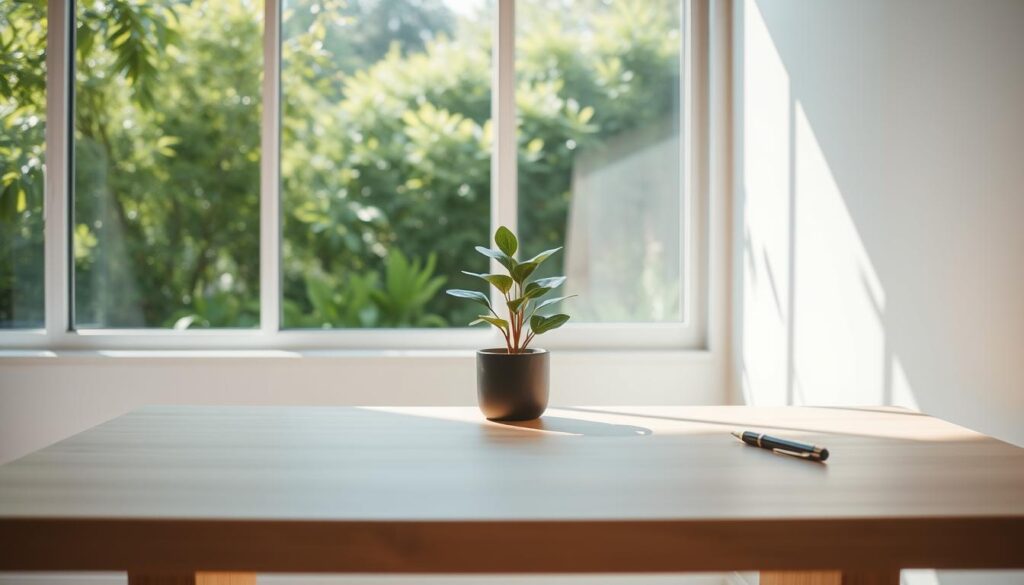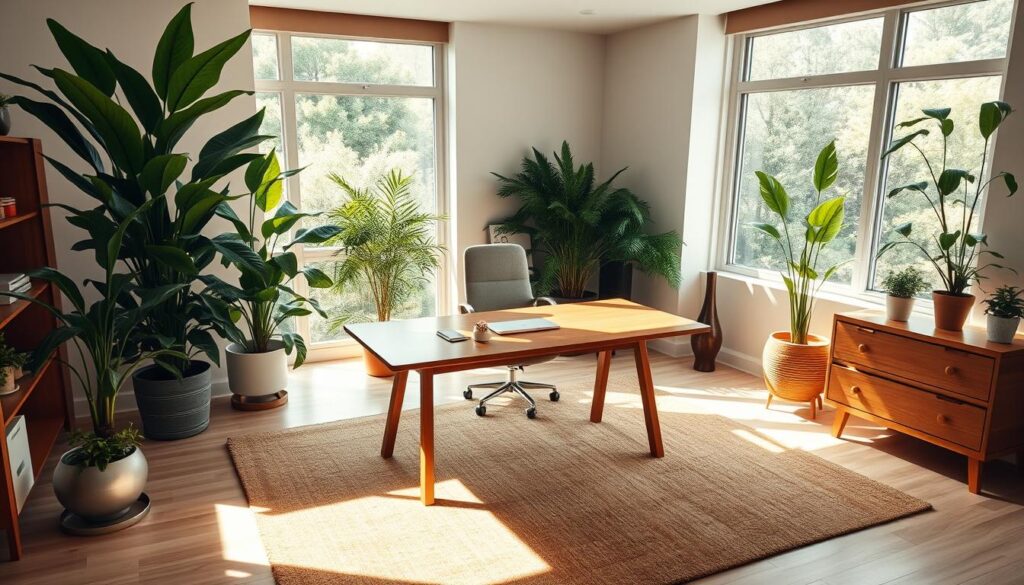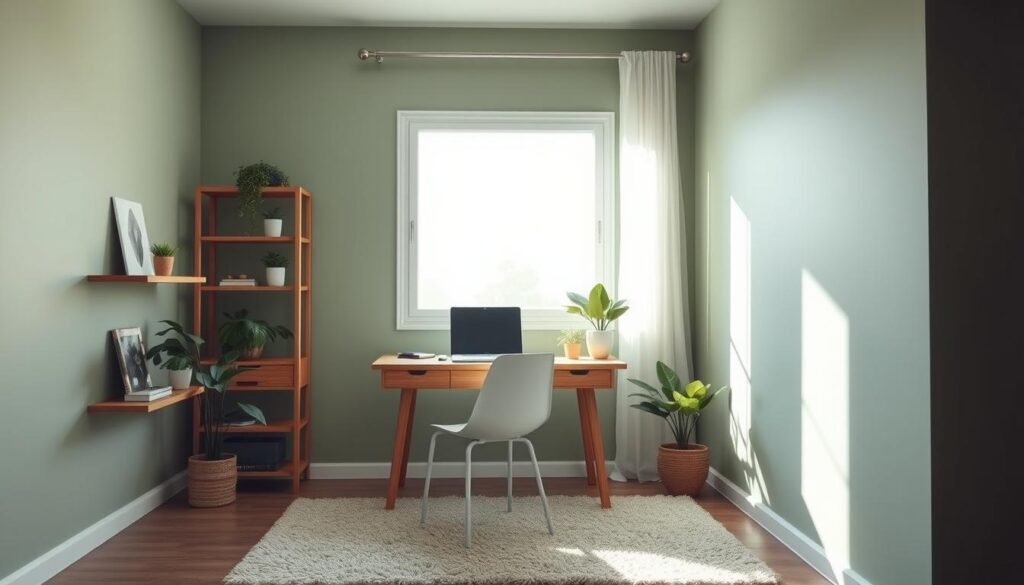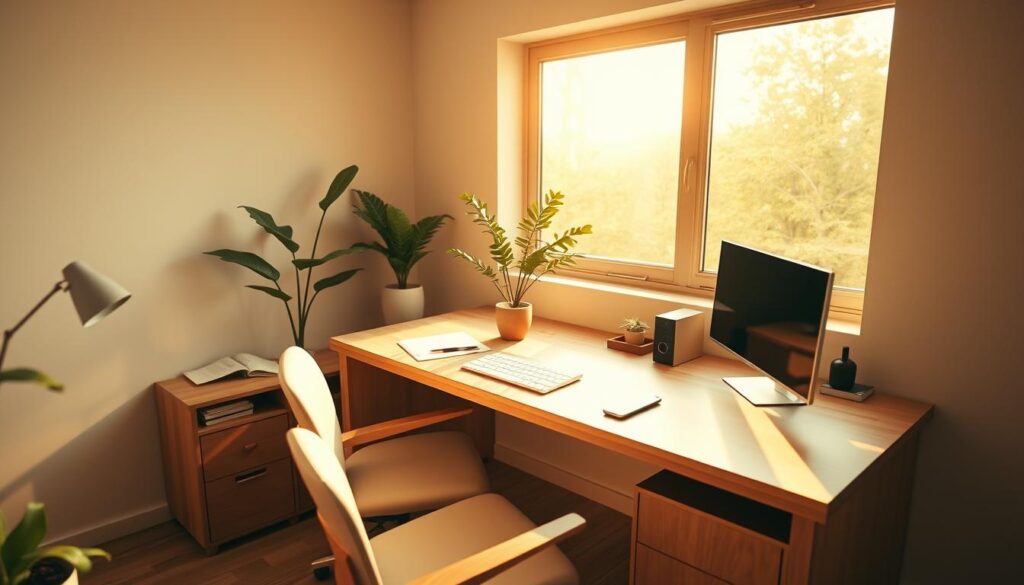More people than ever are working remotely, and the way we design our workspace plays a big role in productivity and well-being. A calming, clutter-free environment can reduce stress while helping you focus better.
Simple changes like natural lighting, neutral colors, and ergonomic furniture create a balanced atmosphere. This approach blends functionality with tranquility, making your daily tasks feel less overwhelming.
Studies show that well-designed spaces improve mental clarity and efficiency. Whether you have a dedicated room or just a corner, small upgrades can make a big difference. For more inspiration, check out these decor ideas that complement a serene setup.
Key Takeaways
- A tidy workspace reduces stress and boosts focus.
- Natural elements like light and plants enhance mood.
- Neutral colors and minimal decor create a calming effect.
- Ergonomic furniture supports both comfort and productivity.
- Personal touches make the space uniquely yours.
Why a Zen House Aesthetic Office Boosts Productivity
Productivity isn’t just about effort; your environment plays a key role. Studies show clutter-free spaces reduce mental stress by 50%, letting your brain focus on tasks instead of distractions. A minimalist setup isn’t just trendy—it’s science-backed.
Natural elements like plants do more than beautify. They purify air by 15% and spark creativity. Biophilic design—a fancy term for bringing nature indoors—taps into our innate need for greenery. Even a small desk fern makes a difference.

Colors matter too. Soft blues and greens lower heart rates by 10-15%, creating a calm vibe. Pair them with warm wood tones for balance. Your palette should soothe, not shout.
Noise is a silent focus-killer. Proper soundproofing—like rugs or white noise machines—extends concentration by 25%. Open-plan spaces? Try noise-canceling headphones.
“Mental health at work starts with intentional design.”
Ergonomics are non-negotiable. A well-aligned chair cuts back pain complaints by 40%. Pair it with a desk at elbow height to avoid hunching. Your body will thank you.
Natural light is a game-changer. It boosts vitamin D by 30% and regulates sleep cycles. Position your desk near a window, or use full-spectrum bulbs if sunlight’s scarce.
Small rituals like tea breaks aren’t just cozy—they increase task persistence by 22%. These pauses reset your mind, blending productivity with tranquility.
Cortisol studies reveal traditional offices spike stress. A zen-inspired space, however, keeps stress markers low. The result? Steady energy and fewer burnout days.
It’s about productive tranquility—optimizing sight, sound, and touch to work smarter. Your surroundings should fuel focus, not fight it.
Embrace Minimalism for a Clutter-Free Workspace
A clutter-free desk is the foundation of a productive mindset. Studies reveal that tidy spaces reduce cognitive overload, letting you focus on tasks—not distractions. Start small: clear excess items, then build systems to maintain order.

Declutter Your Desk
Adopt the 5S System—a Japanese method for efficiency:
- Sort: Remove non-essential items (try the 20/20 rule: toss anything replaceable under $20 in 20 minutes).
- Set: Assign homes for essentials, like the PACIFICA Leather Desk Mat for pens and notebooks.
- Shine: Wipe surfaces daily—*visible clutter = mental clutter*.
“Tidying is just a tool, not the destination. The true goal is to create a space that sparks joy.”
Digital decluttering matters too:
- Keep desktop icons under 15 for visual calm.
- Use folders like “Active Projects” and “Archive.”
| Organizer | Best For | Price Range |
|---|---|---|
| PACIFICA Leather Desk Mat | Writing tools, small notebooks | $25–$40 |
| Flexform Infinity Libreria | Vertical file storage | $50–$75 |
Invest in Multifunctional Furniture
Small spaces demand smart solutions. Choose furniture that doubles storage, like:
- Desks with built-in drawers or cable management.
- Wall-mounted shelves (e.g., Flexform’s vertical units).
Ideal for small home offices, these pieces maximize space without sacrificing style.
Incorporate Natural Elements for Tranquility
Nature has a profound impact on our mental clarity and focus—bringing it indoors transforms any workspace. Studies show that natural elements lower stress hormones by 15% while enhancing creativity. Start with simple additions like air-purifying plants or wood accents to create a serene atmosphere.

Best Plants for a Calming Workspace
Not all greenery thrives indoors, but these picks combine beauty with low maintenance:
- Snake plant: Removes 107 toxins and survives in low light. Perfect for forgetful waterers.
- ZZ plant: Thrives with just 25 lux illumination—ideal for dim corners.
- Bonsai trees: Weekly watering keeps these miniatures lush. A living focus aid for your desk.
For a striking feature, try a moss wall. It maintains 60% humidity, doubling as a natural air filter. Pair it with a Nala Soapstone Planter for succulents—this sleek stone piece blends function with earthy elegance.
Use Wood and Stone Accents
Organic textures ground your design with warmth. A teak desk or bamboo shelf adds subtle grain patterns, while stone coasters or bookends introduce rugged contrast. These materials age gracefully, making your space feel timeless.
“Natural materials trigger biophilic responses, reducing heart rate and improving cognitive function.”
Even small touches matter: a driftwood lamp base or slate wall panel can anchor the room’s vibe. Balance hard surfaces with soft fabrics—like a linen chair cushion—to avoid a sterile look.
Design with a Calming Color Palette
Colors shape our mood and focus more than we realize—choosing the right palette can transform your workspace. Smart design choices here don’t just create a pretty look; they reduce eye strain and mental fatigue.

Soothing Colors That Enhance Focus
Pantone’s 2024 Office Color of the Year, Tranquil Dawn (14-4105 TCX), is a soft blue-green that promotes clarity. For north-facing rooms, Benjamin Moore’s “Silver Marlin” adds warmth without overwhelming.
Try these science-backed choices:
- Sage green behind monitors: Cuts glare and eye strain by 30%.
- Gradient walls: Blend “Oatmeal” at eye level to “Mist Gray” near the ceiling for depth.
- Heathceramics’ Tall Modern Cup hues: Earthy terracottas and muted blues inspire subtle creativity.
“Cool-toned walls lower physiological stress markers by 17% compared to bright whites.”
Colors to Avoid in Your Home Workspace
High-energy hues like neon yellow or fire-engine red spike cortisol levels. Instead:
- Replace stark white with creamy off-whites to soften screen contrast.
- Skip busy patterns on large surfaces—they fragment attention.
- Use bold colors only in small doses (e.g., a single notebook or mug).
For a modern look, pair neutral walls with textured accents like a woven rattan chair or linen curtains. Your home office should feel like a retreat, not a carnival.
Optimize Lighting for Focus and Comfort
Lighting transforms how we work—strategic choices can sharpen focus or strain your eyes. The right balance reduces headaches and keeps energy steady. Start by assessing your current setup: is it too harsh, dim, or inconsistent?

Harness Natural Light Like a Pro
Position your desk at a 45° angle from windows to minimize glare. UV-filtering films block 99% of harmful rays while preserving brightness. For precision tasks, aim for 1,000 lux—equivalent to cloudy daylight.
- Circadian lighting systems (like Ketra D3) mimic sunlight shifts, regulating alertness.
- Bert Frank Stasis Table Light simulates dawn, gently waking your mind.
- 500 lux suits general work; bump to 1,000 lux for detailed projects.
Artificial Lighting That Adapts to You
Overhead fluorescents? Swap them for warm, dimmable LEDs (2700K–3000K). Layer sources:
- Task lighting: Adjustable desk lamps (e.g., BenQ WiT) target work surfaces.
- Ambient lighting: Soft wall sconces diffuse light evenly.
- Anti-flicker bulbs: Prevent eye fatigue during long screen time.
“Proper lighting cuts errors by 30% and boosts productivity by 20%.”
Aim for a cohesive environment where light complements your workflow—not fights it. Small tweaks, like a matte monitor hood or bias lighting behind screens, refine the look and function of your space.
Furnish for Ergonomics and Serenity
Your workspace should support both your body and mind—ergonomic furniture and thoughtful accessories make it happen. The right items reduce strain and create a calming atmosphere, so you can work longer without discomfort.

Pick Ergonomic Chairs and Desks
Invest in pieces that adapt to you. The Herman Miller Aeron chair features 8Z Pellicle suspension, distributing weight evenly to prevent fatigue. Pair it with an adjustable-height desk (like the Fully Jarvis) that lifts at 0.4″/sec for seamless transitions.
For smaller spaces, consider the Steelcase Gesture chair. Its 360° arm movement supports natural postures during calls or typing. Your back will thank you by 3 PM.
- Monitor arms: Comply with the 20-20-20 rule (20″ away, 20° tilt).
- Anti-fatigue mats: Reduce leg pressure during standing sessions.
Add Cozy, Functional Accessories
Soft textures balance sleek ergonomics. Try the HORIZON Leather Mouse Pad—its 6° tilt reduces wrist strain. Layer a chunky knit throw over your chair for breaks, or add a felt desk organizer to keep essentials tidy.
“Ergonomics isn’t a luxury—it’s a necessity for sustained productivity.”
Complete the look with a Himalayan salt lamp. Its warm glow reduces glare while adding a touch of comfort. Small upgrades like these merge design ideas with practicality.
Conclusion
Small design tweaks can create a more focused and relaxing environment. From decluttering to optimizing light, each step builds toward a workspace that fuels productivity and calm. Studies show these changes can boost efficiency by 34%.
Start with one upgrade—like a plant or ergonomic chair—then expand. Personalize your home office with textures and colors that inspire you. Quarterly “space audits” help maintain balance.
Ready to transform your routine? Download our free checklist and begin today. Even minor zen-inspired ideas yield lasting benefits for your work and well-being.

